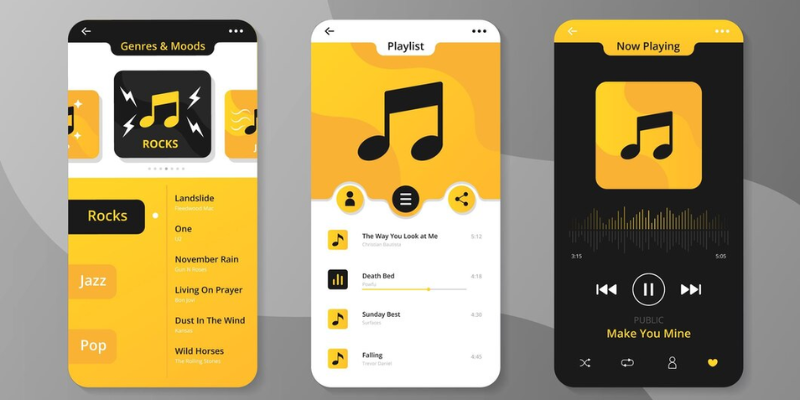Significant Steps To Develop An App Like Podcast

Podcast apps are transforming the sector and opening an excellent chance for fresh players to join the market. Launching your app may attract this expanding audience with customized content and offline listening. If you are looking to take part in this growing market, creating a podcast app could be your golden ticket.
Without couch potato guilt, podcasts have become really popular. It makes sense that the market for podcast apps is hotter than a jalapeño in a sauna, given millions of listeners digesting material on the move.
In this article, we will guide you through the significant steps to creating a podcast app that is more engaging than any other activity. We will discuss key elements to keep consumers engaged and investigate the tech stack required to realize your app. You will also understand how a mobile app development company can help you develop the best podcast app. So get ready to turn your podcast app aspirations into a reality.
After all, one additional listener is always welcome, even in the tech industry!
Define Your Vision
Specify Your Target Audience
Clearly identify your target audience before you start working on your podcast app. Are you trying for passionate podcasters who need extensive capabilities for content development and maintenance, or are you serving casual listeners who want simple access to entertainment during their everyday commutes?
Knowing who will use your software facilitates the feature, user experience, and design customization to fit their particular demands.
Fundamental Goals
Once you know your audience, specify the main goals of your application. Are you more concerned with streamlining content discovery with simple search capabilities or improving user engagement with tailored recommendations?
If your software targets content makers, you might prioritize in-depth statistics and flawless episode uploading. Clearly defined goals guarantee that your podcast app is not only competitive and appealing in the busy podcasting scene but also in line with its consumers’ expectations.
Essential Features for a Podcast App
These are some of the most essential features to include in a podcast app. You can even hire a mobile developer to help integrate these.
User Verification
Offer safe sign-up and login choices with social media connections, including Apple, Google, or Facebook. This simplifies the onboarding process and lets customers register accounts rapidly, enabling access to tailored content and features.
Podcast Directory
Provide a thorough and searchable collection of podcasts so consumers may quickly peruse genres, trends, and categories. Filters in a well-organized directory enable consumers to find new podcasts catered to their interests and maintain their engagement.
Playback Controls
Add play/pause, skip, rewind, and speed control among basic playback tools. Whether they are binge listening or skimming through material, these options let consumers personalize their listening experience, hence increasing their flexibility and enjoyment.
Notifications and Subscriptions
Let consumers sign up for their preferred podcasts and get alerts for new episodes. This will guarantee that customers return to the app often by keeping them informed and involved with the newest material.
Offline Listening
Give consumers the choice to download episodes of podcasts for listening offline. For commuters or those without steady internet access, this function is crucial since it lets continuous listening even in places with bad connectivity.
Personalization
Using algorithms, recommend podcasts based on listeners’ tastes and behaviors. Customized recommendations keep listeners interested and ready for more by providing materials that fit their likes, therefore enhancing user retention.
User Profiles
Customizable profiles let users and podcasters create offering a more customized experience for listeners and a professional platform for podcasters to handle material; these profiles can highlight preferences, subscriptions, and favorite podcasts.
Social Sharing
Link with social networking sites like Facebook, Instagram, and Twitter to let consumers forward episodes to their networks. Social sharing improves app exposure and motivates recent users to explore and interact with your podcast app.
Search Functionality
Provide a strong search tool that lets consumers locate podcasts by title, host, episode name, or even keywords. Advanced filtering choices enable viewers to quickly find particular episodes within large podcast archives and identify fresh content.
Ratings and Reviews
Let people review and score podcasts included in the app. This function guides listeners in choosing what to listen to and motivates podcasters to enhance the quality of their materials depending on user comments.
Playlist Creation
Let users create personalized playlists with their preferred episodes of a podcast. This function lets listeners arrange material according to their tastes, facilitating binge-listening or saving episodes for future listening sessions.
You can hire the best music streaming app development company, which can help you develop your dream app easily.
User Experience (UX) Design
User Interface (UI) Design
Create an aesthetically pleasing and user-friendly interface to keep consumers involved. The design should be straightforward but appealing so that consumers may quickly access the things they need without uncertainty.
Navigation
When designing flawless navigation, give top priority to user experience. Simple and straightforward menus, tabs, and search tools improve general usability so that users may easily find podcasts or control settings.
Accessibility
Incorporate screen readers, customizable font sizes, and contrast settings to ensure that your podcast app is accessible to everyone, including those with disabilities.
Selecting the Proper Tech Stack
To facilitate proper podcast app development, a practical, scalable, easy-to-use, and appropriate technology stack must be chosen. The key technological elements for frontend and backend development are broken down here.
Frontend Development
Since users engage with the front end directly, it must be user-friendly and fluid.
- Frameworks/`Libraries: React Native and Flutter are two well-liked choices that let you create cross-platform applications from a single codebase. Swift is great for developing iOS apps, whereas Kotlin is better for developing Android apps.
- Design Tools: Tools like Figma or Adobe XD offer great design capabilities for UI/UX design, enabling developers and designers to produce user-centered wireframes, mockups, and prototypes.
Backend Development
The backend ensures that the program runs properly by powering the functionality that occurs behind the scenes.
- Server-Side Language: For server-side programming, use Ruby on Rails, Python, or Node.js. These languages are renowned for their effectiveness and scalability.
- Database Management: For efficient data management, you can use PostgreSQL, MongoDB, or MySQL, depending on the architecture and size of your application.
- APIs: Streaming services, social networking networks, and podcast directories can all be integrated using APIs to guarantee smooth content delivery and improved app functioning.
Cloud Services
Cloud services are essential for hosting and controlling the performance of apps.
- Hosting: AWS, Google Cloud, and Azure are the top options for scalable hosting systems that can manage increasing traffic.
- Content Delivery Network(CDN): A content delivery network (CDN) facilitates faster and more dependable access to podcast episodes by caching and distributing data across multiple global servers.
Security
Any app must prioritize security in order to safeguard user data.
- Data Encryption: To avoid breaches, make sure all user interactions and data are encrypted.
- Authentication and Authorization: To protect user accounts, implement secure login procedures utilizing JWT (JSON Web Tokens), multi-factor authentication, or OAuth.
Developing and Testing the App
To build an app like podcast you need robust development. Here are some critical steps to a proper development:
Development Process
- Agile Methodology: Adopt an agile methodology to promote flexibility and iterative development. This will allow the team to adjust to changes and input as the project progresses.
- Version Control: Use Git version control to manage code revisions, track changes, and promote teamwork.
Testing Process
- Functional Testing: Conduct comprehensive functional testing to ensure that every feature works as intended and satisfies the app’s requirements.
- Performance Testing: Verify the app’s responsiveness and performance to ensure that it loads and works properly in a range of circumstances.
- User Acceptance Testing (UAT): Get feedback from real users to identify usability issues and ensure the app meets users’ needs and expectations prior to launch.
Launching and Marketing the App
Effective launching and marketing techniques are required before the launch. Here are some:
Pre-Launch
- Beta Testing: Share a beta version of the app to a small set of chosen consumers for first comments. This allows one to spot any problems and compile knowledge before the official release.
- Marketing Strategy: Plan your marketing to create awareness and excitement. Use social media channels, work with influencers, and use internet communities to create buzz and draw possible users.
Post-Launch
- Monitoring: Use analytics tools to constantly monitor user comments and app performance. This clarifies any problems and helps one grasp user behavior.
- Updates and Improvements: Use technology developments and user comments to guide consistent upgrades. Maintaining the app current guarantees its relevance and fits the changing needs of consumers.
Conclusion
Developing a great podcast app requires establishing your vision, including basic features like user identification and playing controls, selecting the appropriate tech stack, and stressing the overall user experience.
The approach consists of agile development, extensive testing, and a strategic launch plan. These guidelines will help you produce a unique and useful podcast app that distinguishes itself on the market.
All set to realize your concept for a podcast app? Begin your development right now, or contact a podcast app development company for professional direction and help. Allow your app to be the next major podcasting trend!



